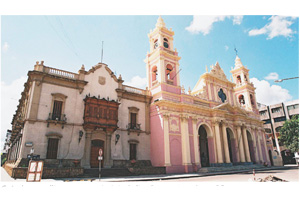The peoples that inhabited the southern zone of the American continent, particularly those who lived throughout the territory of modern day Chile (Chinchorro, Diaguita, Arica, San Pedro, Cabuza, Pica, Llolleo, Pitren and El Vergel) and the Northwest of Argentina (Tafi, Condorhuasi, Cienaga, La Aguada and Santa Maria) are known as pre-Columbian cultures of the Southern Andes. They were great hunter-gatherers and farmers. However, pottery and metalwork were the most important legacies left by the villages in these two countries.
Tri-continental
Chile is located in south-western South America and is bounded by Peru to the north, by Argentina and Bolivia to the west, by the South Pole to the south and by the Pacific Ocean to the west. The country’s main characteristic is that it is tri-continental, which means it is a State which exercises sovereignty over territories located in three continents: America, Antarctica and Oceania. Continental Chile is Chile’s territory in America. Furthermore, it has incorporated several islands into its territory (Easter Island, the Juan Fernandez Archipelago and the islands of San Felix, San Ambrosio and Salas y Gomez), known as Insular Chile as well as the Chilean possessions located in Antarctica.
The country has a population of 15,116,435 (2002 Census) and its capital is Santiago. It is a Presidential Democracy governed by the Political Constitution of the Republic of Chile, approved on the 11th of September 1980, put into effect in March of the following year. It has, however, been amended nine times, the last amendment being one of the most important (26th of August, 2005).
Mining Country
The Chilean economy is based chiefly on mining, as its main resource is copper. Chile is presently the world’s biggest producer of this metal. During 2005, exports exceeded 39.536 billion dollars. Following mining in importance is the industrial sector, which not only generates significant income but also employs a large segment of the country’s workforce.
The fishing industry is divided in two sectors: traditional and industrial. The first is targeted at local consumption, the most abundant species being hake, horse mackerel, blue mussels, clams, etc. In industrial fishing, the catch is taken to plants where fishmeal is produced as well as frozen and canned goods.
Forestry, agriculture and livestock industries are located in the centre and south of the country. As far as crops go, fruit is grown for export, such as apples and grapes; and there are industrial crops (beetroot and tobacco) and cereals (wheat, rice, etc.).
Northeast Argentina: An Area of High Peaks
This area today takes in five provinces: Tucuman, Salta, Jujuy, Santiago del Estero and La Rioja. It has a population of 3.5 million and is one of the most attractive areas in Argentina because of its contrasting landscapes, varying from the highlands and the eastern Andes to the mountainous sub-tropical jungle.
This region’s main crop is sugar cane, and almost 90% of all national sugar cane crops are grown there. This is followed by tobacco, with almost 70% of total national production taking place in this region.
There are also important mineral resources, of which petroleum and gas are the most important even though their production has recently dropped.
Iron, tin, silver and borates are also mined. Borates are used in the ceramics, glass and pharmaceutical industries. Furthermore the world’s largest deposits of lithium salts were found in the highlands a while ago. This mineral is considered the fuel of the future, as the fusion of its atoms should be able to produce high yield, non-polluting energy.
The most appealing places for tourists are Quebrada de Huamaca, Santa Maria-Guachipas, and the small villages with historical buildings such as the churches of Tilcara, San Carlos, Cachi, Tumbaya and Yabi.








